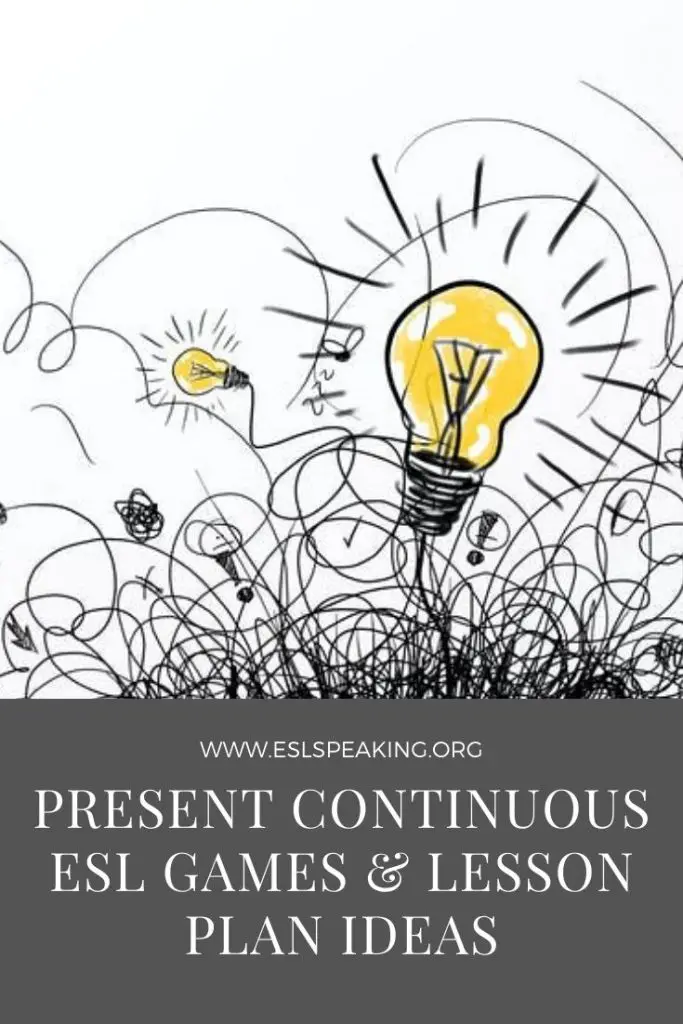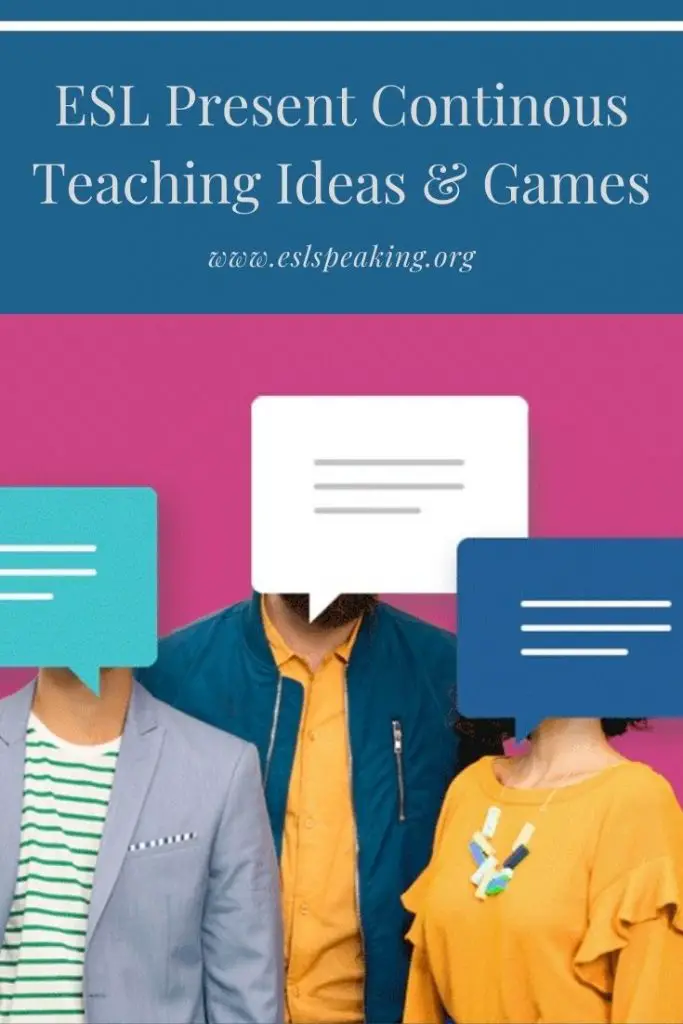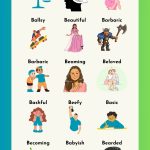If you’re looking for some present progressive or present continuous ESL activities or games, then you’re certainly in the right place. We have some nice ones for you to try out, along with worksheets and lesson plans. Keep on reading for the best present continuous activities and games to try out.

Present Continuous Activities
Let’s get into the present progressive activities and games to try out with your students. But first of all, when do we use this verb tense? It basically describes something that is happening now and may or may not continue into the future (I’m eating dinner, he’s playing soccer).
#1: Picture Prompt
Have a look at one of the best present continuous activities to try out with your students:
This is the perfect activity to introduce the present progressive because it’s used to describe an action that is currently happening! Find a picture that has lots of action in it. Then, ask students, “What’s happening?” They can respond with statements like:
- The man is walking his dog.
- A Mom is playing with her kids.
- The kids are playing soccer.
- The businesswoman is talking on her phone.
It’s possible to ask follow-up questions like:
- Where do you think the man is going?
- Are the kids having fun?
#2: Vocabulary Auction
This is a fun present continuous game that your students will love! It does take a bit of preparation time so I’ll generally only do it if I can recycle it for at least one more class.
Prepare a bunch of sentences using the present progressive. Then, cut them up into individual pieces, word by word. Students have to bid on words that they think will help them make complete sentences. After that, there’s a trading round and then you can see who has the most sentences.
Try this out at least once during the semester! It really is a fun TEFL activity:
#3: Present Progressive Tense ESL Board Game
It’s easier than you might think to design your own board game for just about any topic or grammatical point, including this one. Have a look at this video to find out how to make a fun present continuous activity:
#4: Conversation Starters
If you tell students to make some questions using the present continuous and then talk to their partner, you may be met with silence! It has certainly happened to me before.
That’s why I like to give students some conversation starters. I also encourage free talking and going where the conversation leads but it’s nice for students to have a backup in case they don’t know what to say.
Here are some examples of starters:
- Are you going to work out after class?
- Are you studying English now?
- Where are going after class?
- Are you thinking about eating less meat in the future?
- What are you planning on doing tonight?
#5: Dialogue Substitution
Maybe your students are kind of like mine? If I ask them to read a dialogue from their ESL textbooks, they just blow through without paying attention to what they’re reading. Of course, it’s totally my fault. I haven’t given my students a real reason to read carefully.
Something I like to do to turn this into a meaning-focused activity as well is to remove some of the key words. Try out this present continuous activity for yourself and I’m sure you’ll notice a big difference. Find out more about it here:
Dialogue Substitution ESL Activity.
#6: Running Dictation
Find, or write a conversation between two people with lots of uses of the present progressive. Then, students have to work together to dictate the conversation. Once they’re done that, they have to put the conversation in the correct order.
Try out this 4-skills ESL activity for yourself and I think your students will have as much fun as mine do! It’s ideal for a sleepy Monday morning or late Friday afternoon class to get a bit of energy back into a TEFL lesson. Learn more about it here:
ESL Running Dictation Activity.
#7: Present Continuous Game (Hot Potato)
If you teach children and want to create some fun and excitement in your classroom, have a look at this fun game:
#8: Present Continuous Charades
Charades is a simple game that works well for getting students used to using the progressive tense. Think of a bunch of simple actions (eating ice cream, sleeping, playing tennis, etc.).
Then, put students into two teams and they have to take turns acting out the actions while the team guesses what they’re doing. It works particularly well because this verb tense is used to talk about action that is happening at the present time and this is exactly what charades does!
#9: Got to Hand it to You
This is a fun game that takes something not that interesting (error correction) and makes it into a fun relay-race game. Students have to work in teams to correct errors, in this case, ones related to the present progressive. Find out more here:
Got to Hand it to You Error Correction Race.
#10: How to Plan an ESL Speaking Lesson
It’s super easy to plan your own lesson for just about any grammatical point or vocabulary set, including the present progressive. Have a look here at this step-by-step guide:
#11: Where am I?
In teams, students have to think of 2-3 locations. Then, they have to write clues about each location using the present continuous, starting with the most difficult to the easiest. For example, a bank:
- There are lots of people waiting in line.
- Some people are getting out their wallets.
- Someone is using an ATM machine.
Then, pair up teams with another team and play the game together. Or, collect all the papers and play as a class.
#12: Dicto Gloss
This is a nice activity for higher-level learners. Find (or write) a passage that contains lots of examples of the target grammar or vocabulary. Put students into pairs and read out the passage at a faster than normal pace for the level of the students. Students take notes and then compare with their partners to try to recreate what they just heard.
Repeat the process again (with the same partner) and finally, students can compare what they have with the original version. Find out more:
#13: Sentence Building Games and Activities
#14: Test Teach Test Lesson Plan for Present Progressive
Unless students are absolute beginners, it’s likely that they already know a good bit about what you’re teaching them, whether a vocabulary set or grammar point. If I suspect that this is the case, I like to use the test-teach-test approach. The present continuous is one of those things that even beginners may already be quite familiar with.
This involves giving students a test/task of some kind to find out what they know and what they don’t know. Then, tailor the lesson to what they don’t know well. Finally, test again to see if students have made some progress. It’s a nice change of pace from the usual present-practice-production kind of lesson and I like to use this style once in a while.
To find out more about this style of language teaching, have a look here:
Test Teach Test Language Teaching Approach.
#15: Disappearing Text
This is a simple time-filler that can be used at the end of class for a quick review. Write a sentence on the whiteboard using the target grammar. Have students say it out loud. Then, erase a word (or words, depending on the level) and students have to say the sentence again. Eventually, they’ll have to say the entire sentence but there will be nothing on the board.
Have a look at this simple present continuous game:
ESL Disappearing Text Activity.
#16: Error Correction Game
#17: Sentence Building Games and Activities
Time spent building better sentences is never wasted time! That’s why I like to spend some time on this in class. The present progressive is the perfect time for this as it can get a bit tricky, especially with negative forms.
Have a look at some of my favourite activities to work on this:
ESL Sentence Building Activities.
#18: English Drill Games
The present continuous can be a bit tricky when it comes to word order. That’s why I like to do some drills on it with my students. Here are some of the things that I do:

Present continuous speaking activities
#19: Find Someone Who
Give each student a list of present continuous sentences (e.g., “Someone is reading a book.”). They need to find classmates who are currently doing those activities and ask them to confirm. This is one of my favourite present continuous speaking activities.
#20: Present Continuous Bingo
Create bingo cards with present continuous actions written in the squares. Call out sentences describing actions, and students mark the corresponding action if they have it on their card.
#21: Picture Stories
Show students a series of pictures illustrating different actions. Have them create sentences using the present continuous tense to describe what’s happening in each picture.
#22: Action Chain
Begin a sentence using the present continuous tense (e.g., “I am eating…”), and have students continue the sentence by adding another action (e.g., “…while watching TV.”). Keep the chain going.
#23: Interview Partners
Pair students up. One student interviews the other, asking questions using the present continuous tense (e.g., “What are you doing this weekend?”). Then switch roles. This makes a really nice present continuous speaking activity.
#24: What’s Missing?
Display a set of present continuous sentences on the board. Remove one or more words from each sentence. Students take turns filling in the missing words to complete the sentences correctly.
#25: Time Capsule
Ask each student to write a diary entry about their day using the present continuous tense. Collect the entries and distribute them later for a guessing game where students match the entries with their authors.
#26: Story Building
Start a simple story using the present continuous tense. Each student adds a sentence to the story, continuing the plot and using the tense correctly.
#27: Simon Says
Play the classic “Simon Says” game using present continuous actions. Give commands using the tense, but students should only follow if you say “Simon says” before the command.
#28: Dice Roll
Assign different actions to numbers on a dice. Students take turns rolling the dice and making sentences using the present continuous tense based on the action they rolled.
Present Progressive ESL Lesson Plans
Here are some of my top picks for present continuous lesson plans:
ESL Present Continuous Worksheets
If you’re a teacher, then you already know how much time it can save to use materials that other teachers have created. Here are some of the top options for present continuous worksheets and present progressive exercises.
Present Continuous ESL FAQs
There are a number of common questions that people have about teaching this English grammar concept. Here are the answers to some of the most popular ones.
What is the present continuous?
The present continuous is a verb form that shows that an action is happening in the present. It may or may not continue into the future. For example:
I’m studying.
They’re eating dinner.
How do you teach present continuous to ESL students?
To teach present continuous to ESL students, do the following:
- Set the context by talking about actions that are happening now.
- Introduce some sentences that use the present continuous.
- Focus on forms (including questions and negatives).
- Students do some controlled practice and then freer practice.
- Review and reinforce as necessary.
Is the present progressive the same as the present continuous verb tense in English?
The present progressive and present continuous verb tenses are the same. They are just two different ways to say the same thing. Both describe an action that is currently happening now.
How do I form the present continuous?
You can form the present continuous by using the following: subject + present tense be verb (conjugated) +verb+ing.
How do you form questions in the present continuous tense?
Invert the subject and “am/is/are” to form questions (e.g., “Are they playing?”).
What’s the typical question word used with the present continuous tense?
The question word “what” is often used (e.g., “What are you doing?”).
Can the present continuous tense be used for temporary situations?
Yes, the present continuous can also be used to describe temporary situations or actions that might not be happening at the moment of speaking.
Give an example of using the present continuous tense for future plans.
“We are going to the movies tonight.”
How can you use the present continuous tense to describe annoyance?
Adding phrases like “always,” “constantly,” or “continually” can show annoyance (e.g., “He is always interrupting me.”).
Is the present continuous tense used for general truths?
No, the present continuous is typically used for actions happening around the current time, not general truths.
Did you like these Present Continuous Activities and Games?
- Amazon Kindle Edition
- Bolen, Jackie (Author)
- English (Publication Language)
- 87 Pages - 10/24/2019 (Publication Date)
Yes? Then you’re going to love this book that you can easily find on Amazon: 39 No-Prep/Low-Prep ESL Grammar Activities and Games for Teenagers and Adults. The key to better TEFL classes is a wide variety of engaging, interactive and fun games and activities and this book will help you get there in style. Plus, they’re easy on the prep!
You can find the book in a variety of formats. Pick up a copy to keep on your bookshelf to use as a nice reference guide. Or, take the digital version with you to your favourite coffee shop for some lesson planning on the go. Or, listen to the audio version for some inspiration on the way to work.
Whatever option you choose, get ready to level up your English grammar teaching. Find out more about the book here:
Have your Say about Teaching the Present Continuous
Do you have any tips or tricks for teaching ESL present progressive? Leave a comment below and let us know what you think about it. We’d love to hear from you.
Also, be sure to give this article a share on Facebook, Pinterest, or Twitter. It’ll help other busy English teachers, like yourself find this useful resource.

Last update on 2024-04-14 / Affiliate links / Images from Amazon Product Advertising API







Leave a Reply